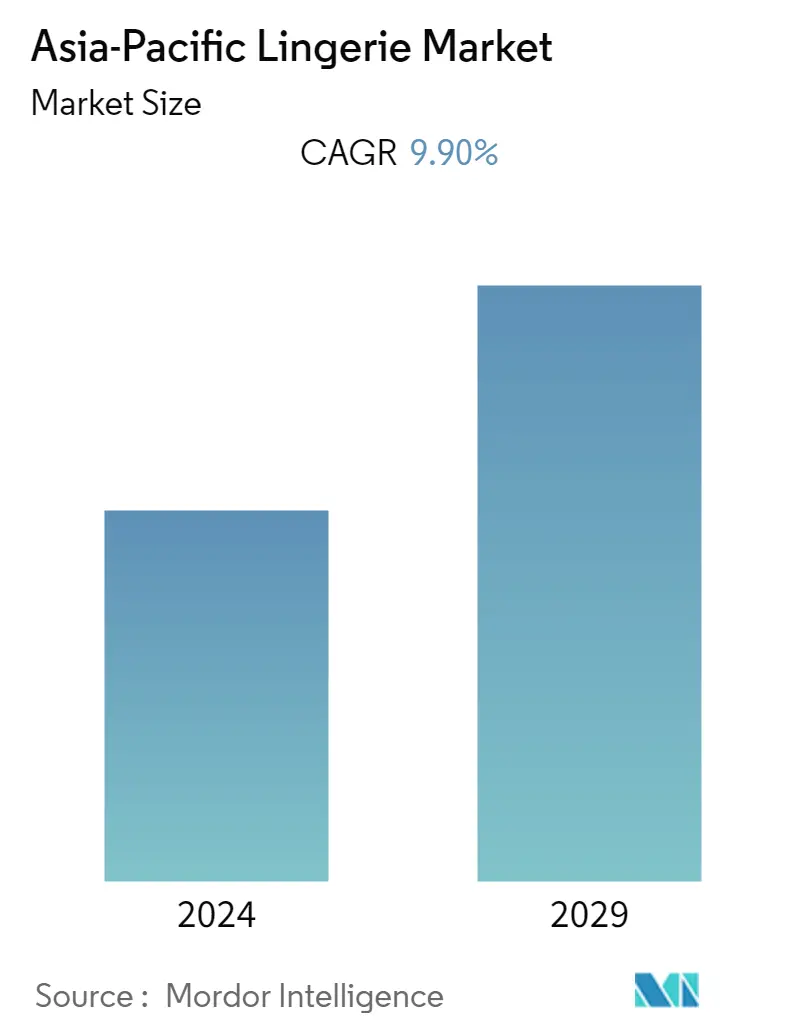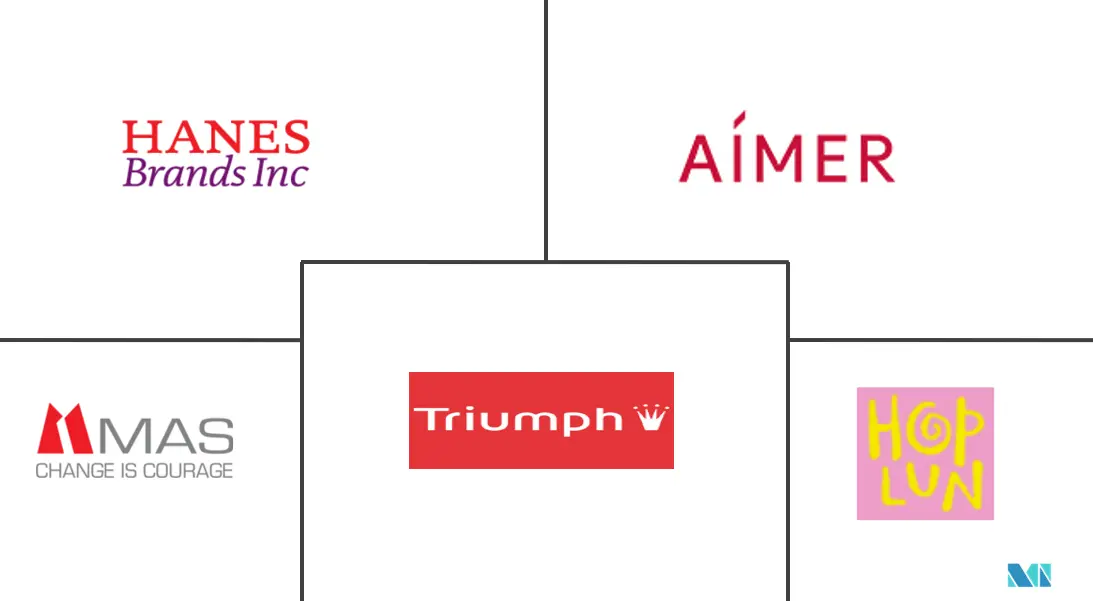Market Size of Asia-Pacific Lingerie Industry

| Study Period | 2019 - 2029 |
| Base Year For Estimation | 2023 |
| Forecast Data Period | 2024 - 2029 |
| Historical Data Period | 2019 - 2022 |
| CAGR | 9.90 % |
| Market Concentration | Low |
Major Players
*Disclaimer: Major Players sorted in no particular order |
APAC Lingerie Market Analysis
Asia-Pacific Lingerie Market is projected to register a CAGR of 9.9% during the forecast period, 2022-2027.
The lasting impact of COVID-19 pandemic on health, social and economic crises combined cannot be underestimated. With months of lockdowns, international travel bans, and retail businesses shuttered, purchase and usage behavior has changed dramatically across the lingerie space, and sales have fallen across many lingerie segments. Moreover, the increasing health consciousness among consumers is a huge factor in market growth, making sustainability a fashion trend creating opportunities for many brands to switch to more ethical production, which can benefit the consumers in any way possible. For instance, in April 2021, Clovia, one of India's leading brands for women's innerwear, loungewear, and personal care, introduced "Bra-Bot," an online artificial intelligence (AI) based chatbot to help customers buy the right innerwear and other categories in the bid to improve their customer's online shopping experience closer to assisted offline retail experience and provide its customers technology-driven help for making the right purchase decisions in the product category which boasts of high customer engagement.
The Asia-Pacific Lingerie Market is mainly driven by the expanding popularity of e-commerce, rising disposable incomes, and changing consumer preferences. With the evolution in the fashion industry, lingerie manufacturers have started using fabrics such as nylon, polyester, satin, lace, sheer, lycra, silk, and cotton in their lingerie.
Lingerie brands are putting more of an emphasis on customer needs and expanding their online presence in response to the ever-expanding social consciousness movements. Additionally, the demand for luxury lingerie is supported by consumers' preference for high-end goods. To increase visibility, luxury lingerie brands have aggressively promoted their products via social media and celebrity endorsements. Furthermore, in an effort to catch consumers' attention, these brands have been launching new campaigns.
APAC Lingerie Industry Segmentation
Lingerie is a category of women's clothing, including shapewear, undergarments, and others. This line of garments for women includes bras, panties, and camisoles, among others. A bra, short for brassiere or brassière, is a form-fitting undergarment primarily used to support breasts. The Asia-Pacific lingerie market is segmented based on type, distribution channel, and country. Asia-Pacific Lingerie Market is segmented based on product type into brassiere, briefs, and other product types. By distribution channel, the market is segmented into supermarkets/hypermarkets, specialty stores, online retail stores, and other distribution channels. By country, the market is segmented into China, Japan, India, Australia, and the Rest of Asia-Pacific. The report offers market size and forecasts in value (USD million) for the above segments.
| By Product Type | |
| Brassiere | |
| Briefs | |
| Other Product Types |
| By Distribution Channel | |
| Supermarkets/Hypermarkets | |
| Specialty Stores | |
| Online Retail Stores | |
| Other Distribution Channels |
| By Country | |
| China | |
| Japan | |
| India | |
| Australia | |
| Rest of Asia-Pacific |
Asia-Pacific Lingerie Market Size Summary
The Asia-Pacific lingerie market is experiencing significant growth, driven by factors such as the increasing popularity of e-commerce, rising disposable incomes, and evolving consumer preferences. The market is characterized by a shift towards sustainable and ethical production practices, influenced by heightened health consciousness among consumers. Brands are leveraging technology to enhance the online shopping experience, with innovations like AI-driven chatbots and size-fitting apps improving customer engagement and satisfaction. The market is also witnessing a surge in demand for luxury lingerie, supported by social media promotions and celebrity endorsements. The growing participation of women in fitness and sports activities, coupled with government initiatives to promote a healthy lifestyle, is further propelling the demand for athletic lingerie.
The market landscape is highly competitive and fragmented, with numerous local and international players vying for market share. Key players are focusing on strategic expansions, partnerships, and technological advancements to strengthen their market presence. The rise of online retail channels, offering convenience and a wide range of product options, is significantly contributing to market growth. The discrete nature of online shopping allows consumers to explore various lingerie styles, including luxury and niche segments, from the comfort of their homes. Companies are also expanding their physical presence in emerging markets, such as India, to tap into the growing consumer base. Overall, the Asia-Pacific lingerie market is poised for robust growth, driven by innovation, consumer-centric strategies, and the increasing integration of technology in retail.
Asia-Pacific Lingerie Market Size - Table of Contents
-
1. MARKET DYNAMICS
-
1.1 Market Drivers
-
1.2 Market Restraints
-
1.3 Porter's Five Force Analysis
-
1.3.1 Threat of New Entrants
-
1.3.2 Bargaining Power of Buyers/Consumers
-
1.3.3 Bargaining Power of Suppliers
-
1.3.4 Threat of Substitute Products
-
1.3.5 Intensity of Competitive Rivalry
-
-
-
2. MARKET SEGMENTATION
-
2.1 By Product Type
-
2.1.1 Brassiere
-
2.1.2 Briefs
-
2.1.3 Other Product Types
-
-
2.2 By Distribution Channel
-
2.2.1 Supermarkets/Hypermarkets
-
2.2.2 Specialty Stores
-
2.2.3 Online Retail Stores
-
2.2.4 Other Distribution Channels
-
-
2.3 By Country
-
2.3.1 China
-
2.3.2 Japan
-
2.3.3 India
-
2.3.4 Australia
-
2.3.5 Rest of Asia-Pacific
-
-
Asia-Pacific Lingerie Market Size FAQs
What is the current Asia-Pacific Lingerie Market size?
The Asia-Pacific Lingerie Market is projected to register a CAGR of 9.90% during the forecast period (2024-2029)
Who are the key players in Asia-Pacific Lingerie Market?
Hop Lun (Hong Kong) Limited, MAS Holdings, Aimer Group, Hanesbrands Inc. and Triumph International are the major companies operating in the Asia-Pacific Lingerie Market.

